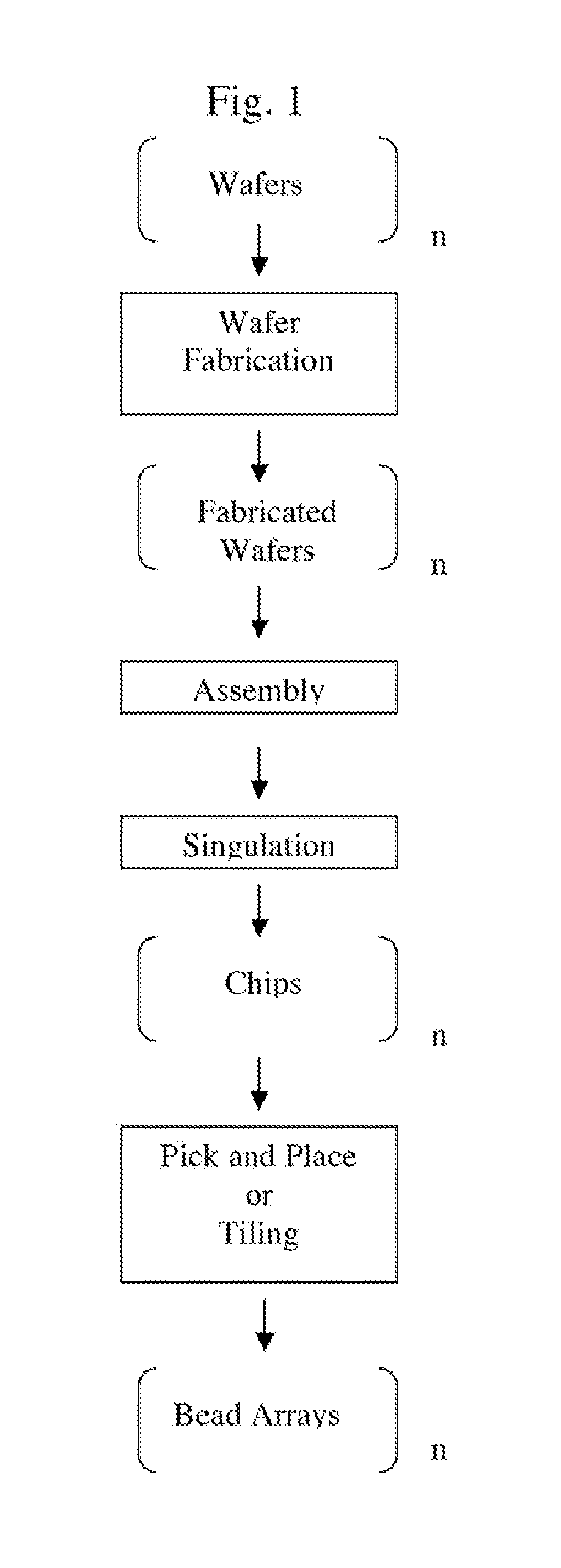Quality control method for making a biochip displaying an encoded bead array
a quality control method and biochip technology, applied in the field of high unit density arrays of microparticles, can solve the problems of significant spot-to-spot variation, the method of probe deposition described to date has failed to produce uniform spots, and the array of low feature density of the art deposition and printing technology, so as to optimize the performance of chip-displayed microparticle arrays. , the effect of high feature density and economies of scal
- Summary
- Abstract
- Description
- Claims
- Application Information
AI Technical Summary
Benefits of technology
Problems solved by technology
Method used
Image
Examples
example 1
Wafer Fabrication and Design of Chips Comprising Bead Arrays
[0111]The fabrication process of the chip comprising a bead array, as shown in FIG. 4, is described in FIG. 11. The substrate was a 100 mm diameter, 0.5 mm thick, silicon wafer with crystal orientation of (100), n-type phosphorus doped. A suitable resistivity range for these wafers is 1.5-4 Ω-cm. Wafers were usually fabricated in batches of up to 25. The first step comprises SiO2 growth. The wafers were first cleaned by the RCA cleaning process, which comprises the steps of (1) soaking the wafers in a mixture of NH4OH:H2O2 (30%):H2O in a volume ratio of 1:1:5 at 75° C. for 10 minutes; (2) rinsing with a cascade water batch cleaning using 18 MΩ-cm water; (3) soaking the wafers in a mixture of HCl (36%):H2O2 (30%):H2O in a volume ratio of 1:1:5 at 75° C. for 10 minutes, and (4) rinsing with a cascade flow water batch cleaning until the water in the bath is at least 16 MΩ-cm. The wafers were spun dry before being placed in a h...
example 2
Functionalization of Beads and Formation of a Bead Array
[0117]Color encoded, tosyl-functionalized beads of 3.2 μm diameter were used as solid phase carriers. Several sets of distinguishable color codes were generated by staining particles using standard methods (Bangs. L. B., “Uniform Latex Particles”, Seragen Diagnostics Inc., p. 40). Stained beads were functionalized with Neutravidin (Pierce, Rockford, Ill.), a biotin binding protein, to mediate immobilization of biotinylated probes or primers. In a typical small-scale coupling reaction, 200 μl of suspension containing 1% beads were washed three times with 500 μl of 100 mM phosphate buffer / pH 7.4 (buffer A) and resuspended in 500 μl of that buffer. After applying 20 μl of 5 mg / ml neutravidin to the bead suspension, the reaction was allowed to proceed overnight at 37° C. Coupled beads (i.e., beads with bio-functional molecules attached thereto) were then washed once with 500 μl of PBS / pH 7.4 with 10 mg / ml BSA (buffer B), resuspende...
example 3
Forming a Bead Array
[0121]A bead slurry was directly dispensed onto the array area on a chip. A wet cotton applicator (K1) was used to gently stir the bead slurry on the array surface. The motion of K1 can be circular, linear or some other meaningful mode, and is usually parallel to the chip surface. After stirring the slurry several times, the beads were moved into the array. Then, the chip surface was cleaned by using K1 to wipe away extra beads that were not in the array. This process can be scaled up from single chips to wafer-scale multi-chip assembly, and can be automated.
[0122]An example of a processing procedure for forming bead arrays is as follows. Two microliters of 1% microparticles (approximately 3.2 micrometers in diameter) in 100 microliters of phosphate-buffered saline (also known as PBS: 150 mM, NaCl; 100 mM., NaP, pH 7.2) were used for assembling eight microparticle arrays on silicon chips (2.5×2.5 mm) with 4,000 microwells on each chip. The following procedures we...
PUM
| Property | Measurement | Unit |
|---|---|---|
| thick | aaaaa | aaaaa |
| thick | aaaaa | aaaaa |
| thickness | aaaaa | aaaaa |
Abstract
Description
Claims
Application Information
 Login to View More
Login to View More - R&D
- Intellectual Property
- Life Sciences
- Materials
- Tech Scout
- Unparalleled Data Quality
- Higher Quality Content
- 60% Fewer Hallucinations
Browse by: Latest US Patents, China's latest patents, Technical Efficacy Thesaurus, Application Domain, Technology Topic, Popular Technical Reports.
© 2025 PatSnap. All rights reserved.Legal|Privacy policy|Modern Slavery Act Transparency Statement|Sitemap|About US| Contact US: help@patsnap.com



